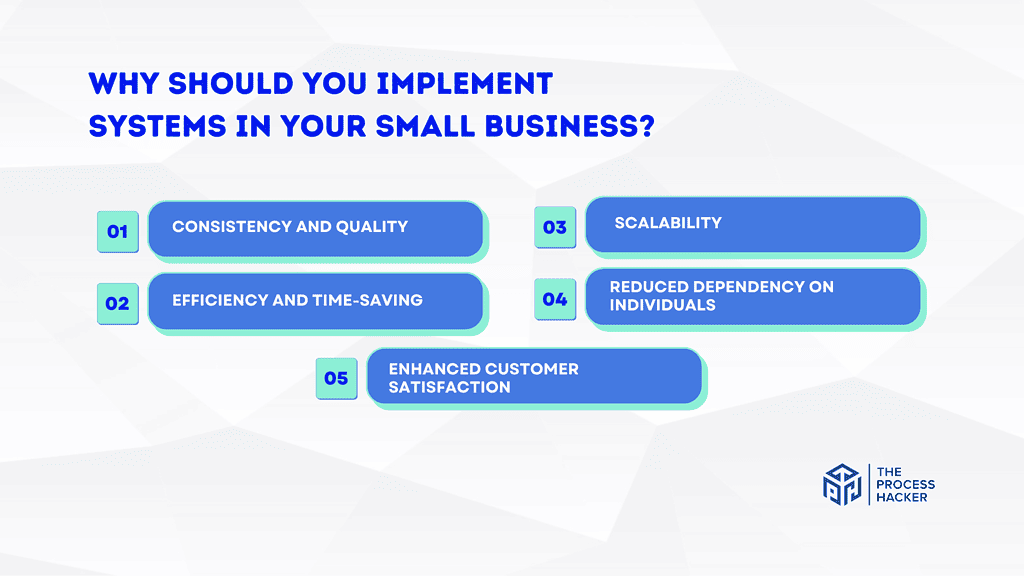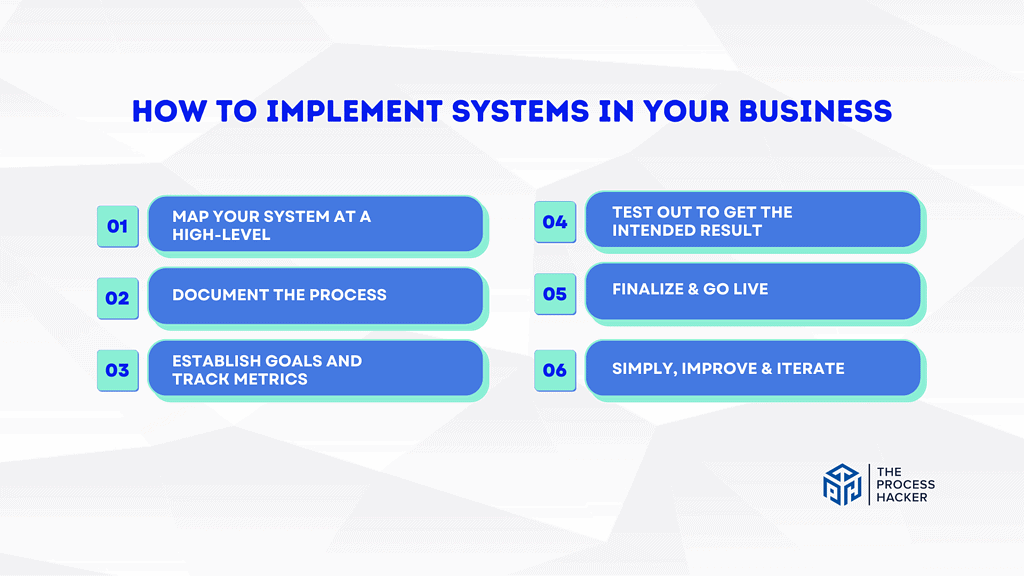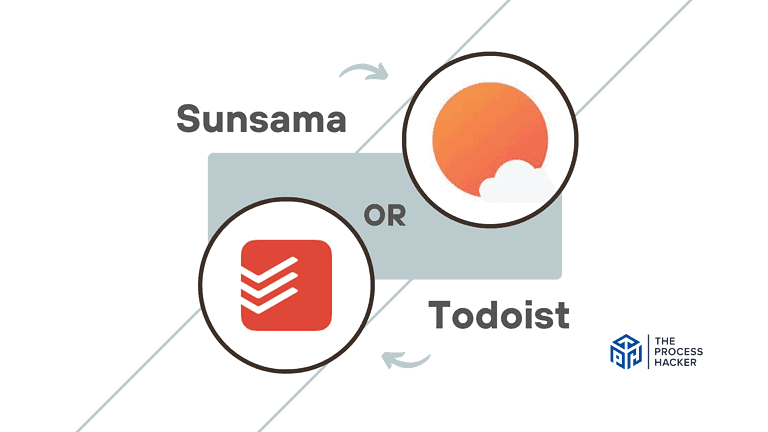How To Create Systems In Your Business: The Process Hacker Way
Are you stuck in a cycle of trying to manage your business but are stuck? And you don’t seem ever to grow, regardless of how hard you work?
If the answer is yes, it’s time to build business systems and automate your business processes!
This guide on “How To Create Systems In Your Business” will show you exactly how to do just that! We’ll teach you simple yet effective strategies for creating effective systems to increase your small business’s efficiency and productivity.
Don’t let yourself get overwhelmed by the day-to-day operations of running a small business.
This blog post will provide the necessary tools to help streamline task management and reduce stress levels daily. Take it further with automation if you want to succeed more as an entrepreneur!
Come on and start optimizing, automating, and scaling your business today!
What Are Business Systems?
Business systems are interdependent components comprising processes, tools, metrics, technology, and team members working cohesively to achieve your business’s objectives.
These systems are the backbone of any business, ensuring that tasks and steps are executed consistently, regardless of who performs them or where they are carried out.
Here’s what makes up your business system:
- Processes: Think of processes as a series of interrelated tasks or steps necessary to complete work in your business. Processes can be created in the form of standard operating procedures (SOPs), templates, videos, and automation tools, each vital in smoothly executing your business activities.
- Metrics: These are the quantifiable measures that help you track and assess the performance of your business process, system, or team member. Metrics act as a compass, guiding you toward your business goals by providing clear indicators of your progress and areas for improvement.
- Technology: Technology is integral to system efficiency in today’s business environment. It supports your processes and metrics, ensuring your business operations are streamlined and effective.
- Team: These are the people who use your system and help you perform specific tasks and responsibilities. They are critical to the success of your business, and their knowledge, skills, and expertise are crucial in executing your daily operations.
Understanding these elements is crucial for creating and maintaining effective business systems. These systems are not just about getting things done; they’re about getting things done efficiently, consistently, and in a manner that drives your business toward its goals.
Why Should You Implement Systems in Your Small Business?
Implementing systems in your small business life is crucial for several reasons. These systems are the bedrock upon which consistent, efficient, and reliable operations are built.

With systems, your business could thrive with consistency, inefficiency, and a lack of scalability. By mastering creating and implementing practical business systems, you position your business for growth, resilience, and success.
- Consistency and Quality: Systems ensure that tasks are executed consistently, maintaining quality regardless of different team members or changing circumstances.
- Efficiency and Time-Saving: Well-designed systems streamline processes, reducing the time and effort required to complete tasks.
- Scalability: Systems allow your business life to handle increased workload or expansion without sacrificing performance or quality.
- Reduced Dependency on Individuals: With systems in place, your company is independent of specific individuals, mitigating risks associated with staff turnover.
- Enhanced Customer Satisfaction: Consistent quality and efficiency improve customer experiences and satisfaction.
My method, centered on the strategic development and implementation of these systems, is tailored to address these critical needs. It is more than just a set of instructions; it’s a comprehensive approach that transforms your company’s core operations.
By following this method, you will understand the importance of systems and learn how to effectively create and apply them, ensuring your business thrives in today’s competitive environment.
This approach is designed to be practical, actionable, and suitable for small businesses of various types, setting you on the path to long-term success and sustainability.
What Are The Systems You Need In Your Business?
Understanding and implementing critical systems is crucial in your journey to business success. These systems are the gears that keep your business machine running smoothly and efficiently. Let’s explore one of the most vital systems you need:
Marketing System
A Marketing System generates qualified leads through content production, every blog post, content promotion, direct outreach, and lead capture strategies.
Establishing a robust marketing system sets the stage for attracting potential customers and nurturing them through your sales funnel.
Remember, a well-crafted marketing system not only attracts leads but also lays the foundation for converting these leads into loyal customers, driving the profitability and growth of your business.
Sales System
Your Sales System is designed to convert leads into customers effectively.
This involves nurturing leads before presenting your offer, guiding them through a launch or to a sales page, and getting them on sales phone calls. Regularly engaging with your leads via email and social media, validating their pain points, and presenting your proven processes as solutions are key aspects of this system.
Additionally, establishing your authority through reviews, testimonials, and case studies helps build trust and credibility with your prospects.
This systematic sales approach increases conversions and strengthens your brand’s reputation and customer relationships.
Fulfillment System
Fulfillment System focuses on delivering quality customer service and turning them into raving fans.
This system encompasses everything from client onboarding to consistently delivering your services. It involves having a clear process for onboarding new clients, ensuring all tasks and processes for service delivery are well-defined, and maintaining regular communication with clients to keep them updated and supported.
Templated responses and tools for scheduling and tracking progress are also crucial. Implementing a robust Fulfillment System ensures that you meet and exceed client expectations, enhancing customer satisfaction and loyalty.
Financial System
A Finance System is designed to help you make money and manage cash flows efficiently.
This includes keeping your business finances separate from personal ones, having dedicated business banking accounts, and ensuring your business is incorporated correctly. It’s also crucial to have a bookkeeper or accountant, or if not, to categorize expenses and reconcile your books regularly.
Timely tax payments, weekly reviews of financial statements and metrics, and close monitoring of profit margins, sales revenue, operating expenses, cash flow, accounts receivable, and accounts payable are all part of a robust Finance System.
This diligent financial management is key to maintaining a healthy financial state for your business and making informed decisions for its growth and sustainability.
Communications System
Your Communications System maintains strong connections with your clients and team members. It encompasses the platforms and strategies you use for both internal team and external client communications.
This system involves creating various channels or forums to organize conversations and information effectively. It also includes using emojis or reactions to express support, acknowledgment, or agreement, facilitating smoother and more efficient communication.
A well-implemented Communications System ensures you stay connected and responsive, fostering a collaborative and supportive environment for your business.
Support Systems
Support Systems are integral in making your business run smoothly, integrating crucial aspects like marketing, sales, fulfillment, finances, and communications.
These systems include project management tools to track all internal and client-related tasks and projects in one place. They also involve having Standard Operating Procedures (SOPs) for all internal team and client-related processes and regularly maintaining and updating these SOPs.
Additionally, efficient storage and management of client information, business metrics, and digital files, backed up on the cloud and organized for easy retrieval, are essential components.
Regular audits and updates of these systems ensure they continually add value and support the seamless operation of your business.
How to Implement Systems In Your Business
Implementing systems in your business is about creating a structure that allows for consistent, reliable, and repeatable execution of tasks, regardless of who is doing the work or where it is being done.

It’s about setting up a framework that supports all aspects of your business – from marketing and sales to fulfillment and finance – and ensures that these components work together seamlessly to drive your business forward.
The upcoming guide will help you step-by-step through the process of establishing and fine-tuning these systems in your business.
You’ll learn how to integrate various elements into a cohesive whole, ensuring your business operations are streamlined and efficient. This method is not just about implementing systems; it’s about evolving your business to a level where growth and efficiency are not just goals but realities
#1) Map Your System at a High-Level
Mapping your system at a high level is your first step towards implementing effective systems in your business. Start by defining the following systems in the simplest terms: Marketing, Sales, Fulfillment, and Finance.
By mapping your system at a high level, you create a clear overview of how each component of your business works together. This holistic view is essential for identifying gaps,and potential improvements and ensuring that all parts of your business are aligned with your overall objectives
#2) Document the Process
The next step to creating systems in your business is to document the process thoroughly. This involves detailing each aspect of your system to ensure clarity and consistency.
These processes are the backbone of your system, consisting of the following components:
What – End Result
Clearly define each process’s outcome or end result in your system. This clarifies the goal and purpose of each step.
Why – Purpose
Describe the purpose behind each process. Understanding the ‘why’ provides context and helps you and your team stay aligned with the business’s objectives.
When – Deadline & Recurring Action
Establish deadlines and schedules for each task. Indicate if actions are one-off tasks or recurring activities, which helps planning and resource allocation.
Who – Roles or Responsible Person
Assign specific roles or people responsible for each task. This ensures accountability and clarity on who handles what part of the process.
How – Tools & Step-by-Step Actions
Detail the tools needed for each process and provide a step-by-step guide on executing each task. This could include process tools like SOPs, blog post optimization, templates, videos, and automation tools.
Documenting your process in this manner helps in maintaining a consistent approach to executing tasks and provides a clear guide for team members, leading to more efficient and effective operations
#3) Establish Goals and Track Metrics
Setting goals and tracking metrics are essential for any small business looking to succeed. When it comes to systems, it’s important to establish clear goals that align with the overall strategy of the company.
These goals should be SMART: simple, measurable, actionable, relevant, and trackable within a reasonable timeframe. This will allow you to not only monitor progress toward a specific goal, but also make adjustments as needed based on the data.
Once the goals are set, it’s important to track metrics that help measure progress towards achieving those goals. Metrics are performance indicators that allow business owners to evaluate their progress and identify areas for improvement.
These metrics could include anything from customer satisfaction rates to website traffic to sales numbers. Regularly tracking these metrics will not only help ensure that you’re on track to achieving your goals, but will also help you identify areas where you can make improvements to your systems and processes.
By establishing goals and tracking metrics, you’ll be able to continually improve your small business and achieve long-term success.
#4) Test Out to Get the Intended Result
After documenting your processes, the next critical step is testing them to ensure they yield the intended results. This involves several key actions:
- Implement and Observe: Begin by implementing the documented processes in real-world scenarios within your business. Observe how they function in practice, not just in theory.
- Collect Feedback: Regularly collect feedback from your clients and team members involved in or affected by these processes. Their insights are invaluable in understanding the effectiveness and areas for improvement.
- Evaluate Metrics: Pay close attention to your key metrics, which give you quantifiable data on the performance and impact of your processes.
- Adjust and Improve: Make necessary process adjustments based on the feedback and metrics. This might involve refining steps, altering tools, or addressing unforeseen challenges.
- Repeat the Process: System implementation is not a one-time task. Continually test and refine your processes. This iterative approach ensures you create effective systems aligned with your business goals and the ever-changing business environment.
By taking these steps, you make sure that your systems do not just exist on paper but work effectively in your business, driving towards the desired outcomes
#5) Finalize & Go Live
Once you have tested and refined your systems based on feedback and data, the next step is to finalize and go live with these systems in your business. Here’s how you can execute this final step:
- Incorporate all the feedback and adjustments from the testing phase into your systems. Ensure your team documents and understands every aspect of the system.
- Ensure that your team is thoroughly trained on the new systems. They should understand each process’s ‘how’ and ‘why.’
- Roll out the systems gradually. This allows smoother transitions and the ability to address any minor issues that arise without overwhelming your operations.
- Even after going live, continue to monitor the performance of your systems. Regularly collect feedback from clients and team members to ensure the systems function as intended.
- Be prepared to make adjustments even after going live. Systems should be flexible enough to evolve with your business needs.
- Finally, celebrate implementing these new systems with your team. Promote the changes to your clients, highlighting how these improvements will benefit them.
By finalizing and going live with your business systems, you solidify the foundation for more efficient, consistent, and scalable business operations. This step marks a significant milestone in your journey toward a systemized and streamlined business.
#6) Simply, Improve & Iterate
The final step in creating systems in your business is to continually simplify, improve, and iterate. This ongoing process ensures that your systems stay relevant, efficient, and effective. Here’s how you can execute this:
- Constantly look for ways of doing things to improve your offer, service, or business operations. This could involve streamlining processes, incorporating new tools, or adopting better strategies.
- Regularly gather feedback from your clients and use it to refine your services. Feedback is a valuable tool for understanding client needs and expectations.
- Be open to implementing new projects or initiatives to enhance your business operations. This keeps your business dynamic and adaptable.
- Have a system for client offboarding and actively ask for referrals from satisfied clients. This helps in building a solid client base and enhances word-of-mouth marketing.
- Make it a habit to collect testimonials from your true-to-life best clients. Testimonials are powerful tools for building trust with potential clients for life.
- Monitor key metrics like Lifetime Value (LTV) and Net Promotor Score (NPS). These metrics provide insights into the health and success of your business.
- Finally, remember that system creation is not a one-time activity. Continually iterate and refine your systems to ensure they evolve with your business needs and the market.
By simplifying, improving, and iterating your systems, you ensure that your business keeps up with the times and remains a step ahead in efficiency and client satisfaction.
Key Considerations For Successfully Implementing Business Systems
When implementing business systems, it’s essential to keep a few key considerations in mind:
- Flexibility and Adaptability: Create systems that should be flexible enough to adapt to changing business environments. While consistency is crucial, rigidity can hinder growth. Be prepared to modify systems as your business evolves.
- Employee Involvement and Training: The success of any system largely depends on the people who use it. Involve your team in the development of these systems and provide thorough training. Their insights can offer valuable perspectives that improve the system’s effectiveness.
- Continuous Monitoring and Evaluation: Regularly monitor the performance of your systems. Use metrics and feedback to evaluate their effectiveness. This ongoing evaluation helps identify improvement areas and ensures that your systems align with your business goals.
Implementing systems in your business aims to create rules and procedures and establish a culture of efficiency, clarity, and continuous improvement. These considerations will guide you in creating effective and sustainable systems in the long run.
Taking it to the Next Level: Schedule A Call With Me Today!
If you’re ready to enhance and elevate your business systems beyond what this tutorial has covered, check out our services page or schedule a call with me!
In our conversation, we can delve deeper into the unique aspects of your business, identifying specific challenges and opportunities that are not addressed in a general guide. Together, we can explore advanced strategies tailored to your business’s needs, industry trends, and personal goals.
During our call, we can focus on fine-tuning your systems for maximum efficiency, discuss the integration of cutting-edge technologies, and brainstorm innovative solutions for complex challenges.
Whether scaling your operations, automating more processes, or enhancing team collaboration and productivity, a personalized consultation can give you the insights and guidance necessary to take your business systems to the next level.
Remember, every business is unique, and a one-size-fits-all approach rarely works. By scheduling a call, you’re taking a proactive step towards bespoke solutions that can significantly impact your business’s growth and success in the dynamic business landscape.
Final Thoughts On Creating Systems In Your Business
As we wrap up this comprehensive guide on “How To Create Systems In Your Business,” reflecting on our journey is essential.
From mapping out high-level systems to testing, finalizing, and continuously iterating them, each step is integral to building a business that is efficient, scalable, and ready to meet the demands of a dynamic market.
The processes outlined here provide a solid foundation for structuring your business operations, ensuring consistency and quality in every aspect of your work.
My experience and way of doing things, developing and implementing business systems has taught me the value of organization, clarity, and strategic planning.
As someone who has navigated the complexities of business operations, I’ve witnessed firsthand how well-designed systems can transform an organization, fostering growth, enhancing productivity, and improving client satisfaction.
My guidance is rooted in real-world experience and a deep understanding of creating and maintaining systems that work and thrive.
Remember, the journey to perfecting your business systems is ongoing. As your business evolves, so too should your systems.
Please take what you’ve learned here and continue to build upon it, always striving for excellence in every facet of your business.
And if you’re looking for more personalized advice or advanced strategies, don’t hesitate to schedule a call with me. Together, we can take your business systems to new heights.















